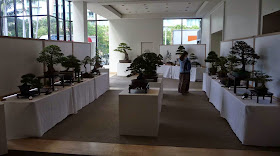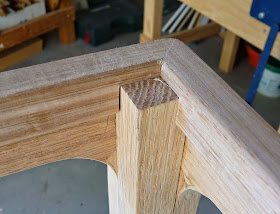The convention ran over three days at a big hotel in Surfer's Paradise with Australian, Indian, Indonesian, Chinese and Japanese demonstrators.
The exhibition of trees, some 70 to 75 in number, were mostly from South East Queensland and there were some very impressive trees amongst them. There were a couple of notable exceptions from Canberra.
I'm sure with these interpreter interfaced presentations there are a few things lost in translation but the process worked pretty well. I came away with a feeling that these things are a little more entertainment than learning opportunities. Seeing one more juniper styled from raw material is not going to advance my skills. All you can really hope for is the odd gem, reinforced enthusiasm and the pleasure of a shared interest with hundreds of other folks for a few days solid.
These two shots are of the exhibition area. The part close to the big southern windows was full of daylight and white space while the other part was not quite as bright. It was a well mounted display with lots of work done to make custom tables and backings.
Putting these things on is a huge task and there would be hundreds of minor and major details that all need to be pulled together at the right time. The reality is that it takes years of lead time and countless pre-commitments and agreements in the planning. A smoothly flowing convention is testament to the time put in well before the doors opened. Congratulations to the organisers and the many volunteers who spared no effort.
On a personal level I had a pretty good conference. I had two trees in the exhibition as well as 4 pots and 4 stands. I came home with one of three awarded BCI Excellence Awards for my Lilly Pilly, which has now gone to the National Collection in Canberra for a year. And not only that: There were daily raffles of donated prizes and on the last day I won a viewing stone, which was donated by Budi Sulistyo from Indonesia. Might have had something to do with the 20 entry tickets I put in that box. This is my very first stone but will it be the last, hmmmmmm? I'm not yet a 'stone man' and I can guarantee my wife is even further away from conversion. Half a dozen pot sales and a booking for a pot making demonstration rounded out the weekend.
Here are some pictures of a few trees in the exhibition:
The exhibition of trees, some 70 to 75 in number, were mostly from South East Queensland and there were some very impressive trees amongst them. There were a couple of notable exceptions from Canberra.
This group of corky bark chinese elms was styled by Shinichi Nakajima.
This was the marble slab penjing by Zhao Qingquan
And here he is in full flight.
I'm sure with these interpreter interfaced presentations there are a few things lost in translation but the process worked pretty well. I came away with a feeling that these things are a little more entertainment than learning opportunities. Seeing one more juniper styled from raw material is not going to advance my skills. All you can really hope for is the odd gem, reinforced enthusiasm and the pleasure of a shared interest with hundreds of other folks for a few days solid.
These two shots are of the exhibition area. The part close to the big southern windows was full of daylight and white space while the other part was not quite as bright. It was a well mounted display with lots of work done to make custom tables and backings.
Putting these things on is a huge task and there would be hundreds of minor and major details that all need to be pulled together at the right time. The reality is that it takes years of lead time and countless pre-commitments and agreements in the planning. A smoothly flowing convention is testament to the time put in well before the doors opened. Congratulations to the organisers and the many volunteers who spared no effort.
On a personal level I had a pretty good conference. I had two trees in the exhibition as well as 4 pots and 4 stands. I came home with one of three awarded BCI Excellence Awards for my Lilly Pilly, which has now gone to the National Collection in Canberra for a year. And not only that: There were daily raffles of donated prizes and on the last day I won a viewing stone, which was donated by Budi Sulistyo from Indonesia. Might have had something to do with the 20 entry tickets I put in that box. This is my very first stone but will it be the last, hmmmmmm? I'm not yet a 'stone man' and I can guarantee my wife is even further away from conversion. Half a dozen pot sales and a booking for a pot making demonstration rounded out the weekend.
Here are some pictures of a few trees in the exhibition:

















































